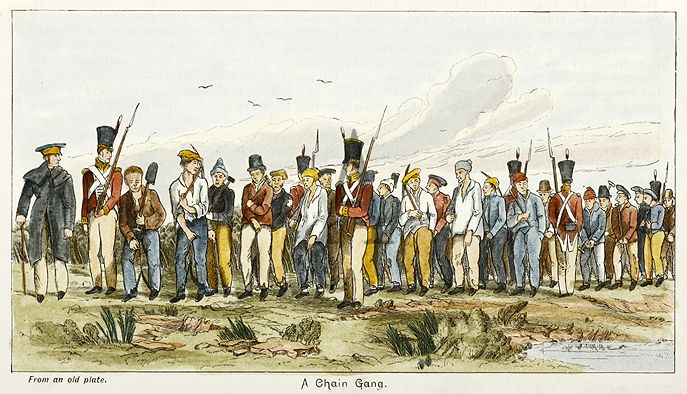The male* convict classification system in Van Diemen’s Land was invented by Colonel George Arthur as part of his mandate to make Australia scary again. It originally applied only to those convicts in Hobart-town not already assigned to live and work for private settlers.
That his system had seven classes must have appealed to the religiously minded Lieutenant Governor when he extended it across his entire domain, reflecting as it did, the second most popular bit of Christian fan fiction ever written, which laid out the geography of hell as a pit with seven levels. Thank you, Dante.


GOVERNMENT NOTICE.
Colonial Secretary’s Office, Aug. 9, 1826.
THE Prisoners’ Barrack in Hobart Town, which has hitherto been considered as a Penitentiary only, will, in future, be appropriated to the Reception of Prisoners in the Service of Government generally, with a View to the more effectual Application of their Labour, and the Prevention of Offences arising from so many Men being at large.
The Lieutenant Governor being, nevertheless, desirous to extend to those of good Character all reasonable Indulgence, has directed the following Classification to be observed, so far as it may be practicable, throughout the Colony, and which is therefore published for the Information of all concerned :
The Heads of Departments are required to make the same known to the Prisoners under their Charge, and to explain, that while the Industrious and well-conducted will not fail to receive due Encouragement, even beyond what is now promulgated, those of irregular Habits will assuredly be compelled to Labour, without Remission, through the several Gradations, until, by the Expiration of their Offences and improved Demeanour, they shall be considered worthy to be restored to the Privileges, annexed to the Second and First Classes, or to the still higher Privilege of being placed in the Service of respectable Settlers :—“GOVERNMENT NOTICE.” The Hobart Town Gazette (Tas. : 1825 – 1833) 12 August 1826: 3. Web. 13 Dec 2022 http://nla.gov.au/nla.news-article8790953.
By the time Arthur was recalled to England, his class system had gone through many revisions — the most dramatic being the change which included Ticket of Leave holders and those assigned to private individuals into classes of their own. This final form was codified in evidence delivered by Arthur to the Molesworth committee in London on 27 June 1837.
Could you state the various classes of the convicts in the colony ? I divide them into seven. The first and most desirable class is that class of convicts who are holding tickets of leave ; then convicts who are in assigned service ; convicts who are on the public works ; convicts who are in road parties out of chains ; convicts who are in road parties in chains ; convicts who are ordered to the penal settlements ; and those who are in the penal settlements in chains.
Arthur/Select Committee, 27 June 1837. Report…. p 279.
Unfortunately, it’s not spelled out in the literature I’ve looked at (so far) when these evolutions occurred. There were subdivisions of classes into subsets that are not always allocated a consistent name within the system, if they are acknowledged to part of it at all.
For example: the loan gangs. These were government assignees (Class III) considered to have skills too valuable to allow a single private setter (Class II) to monopolise. Instead they were formed into a gang (Class IV) and leant out to the public for a fee. This made a mockery of the claim that good or bad behaviour alone was responsible for where any convict was placed within the system. To clarify further— Those in loan gangs were part of Class III by 1837, but among those in Class III who were more equal than others in Class III at the same time. They had been classified as Class I back in 1827.
Here is a comparison between the grades as they were set out by Arthur in 1826 and then in 1837.
1826
1837
Class I
“To consist of such Men, whether Mechanics or Labourers, as from especial good Conduct will be permitted to Sleep out of Barracks, and to Work for themselves the Whole of each Saturday.
“The first and most desirable class is that class of convicts who are holding tickets of leave
Class II
Those for whom Barrack Accommodation shall be provided, and who, subject to a Continuance of good Behaviour, will be allowed to Work for themselves the Whole of each Saturday.
…convicts who are in assigned service
Class III
Men employed on the Public Roads who will be released from Work at Noon every Saturday, subject however to the Condition of good Conduct.
…convicts who are on the public works
Class IV
Refractory or disorderly Characters, to Work in Irons, either in the Towns or on the Roads, Under the Sentence of a Magistrate.
…convicts who are in road parties out of chains
Class V
Men of the most degraded and incorrigible Character, who will be worked in Irons, under the Sentence of a Magistrate, and kept entirely separate from other Prisoners.
…convicts who are in road parties in chains

Class VI
Men removed to Maria Island, subject to the Classification of the Commandant there.
…convicts who are ordered to the penal settlements
Class VII
Men removed to Macquarie Harbour, subject to the Classification of the Commandant there.
… those who are in the penal settlements in chains

The Seventh Level of Hell
If there’s a take-away from any of this, I think that anyone who tries to simplify Van Diemen’s Land’s — or any Australian Convict System, for that matter — down to a single definition is deluding themselves and misleading others.
*Female prisoners had a different classification system of their very own, which (very roughly) substituted being sent to a penal settlement with being sent to a Female Factory.


Leave a Reply